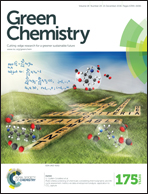Design and synthesis of micro–meso–macroporous polymers with versatile active sites and excellent activities in the production of biofuels and fine chemicals†
Abstract
Micro–meso–macroporous polymers (MOPs) grafted with versatile functional groups, such as sulfonate, amine, triazole, pyridine, strong acidic ionic liquids and triphenylphosphine, were synthesized by in situ cross-linking of different functional molecules with 1,4-bis(chloromethyl)benzene in the presence of Lewis acid catalysts without using additional templates. The resultant hyper-cross-linked nanoporous polymers show unique characteristics such as large BET surface areas (up to 1523 m2 g−1), abundant micro–meso–macropores (4.5–131 nm), and tunable and versatile active sites (acid, base and palladium). These functional polymers exhibit excellent activities and good reusability in biomass conversions, cross-coupling reactions and condensation. The catalytic activities are much better than those of various conventional catalysts such as H3PW12O40, SBA-15-SO3H, Amberlyst 15, and mesoporous H-ZSM-5 Pd/C and even as comparable as those of homogeneous H2SO4 and HCl in the depolymerization of crystalline cellulose into fine chemicals and towards transesterification to biodiesel. This work highlights a low cost route to the synthesis of solid catalysts based on functional nanoporous polymers for catalyzing the production of clean biofuels and fine chemicals.


 Please wait while we load your content...
Please wait while we load your content...